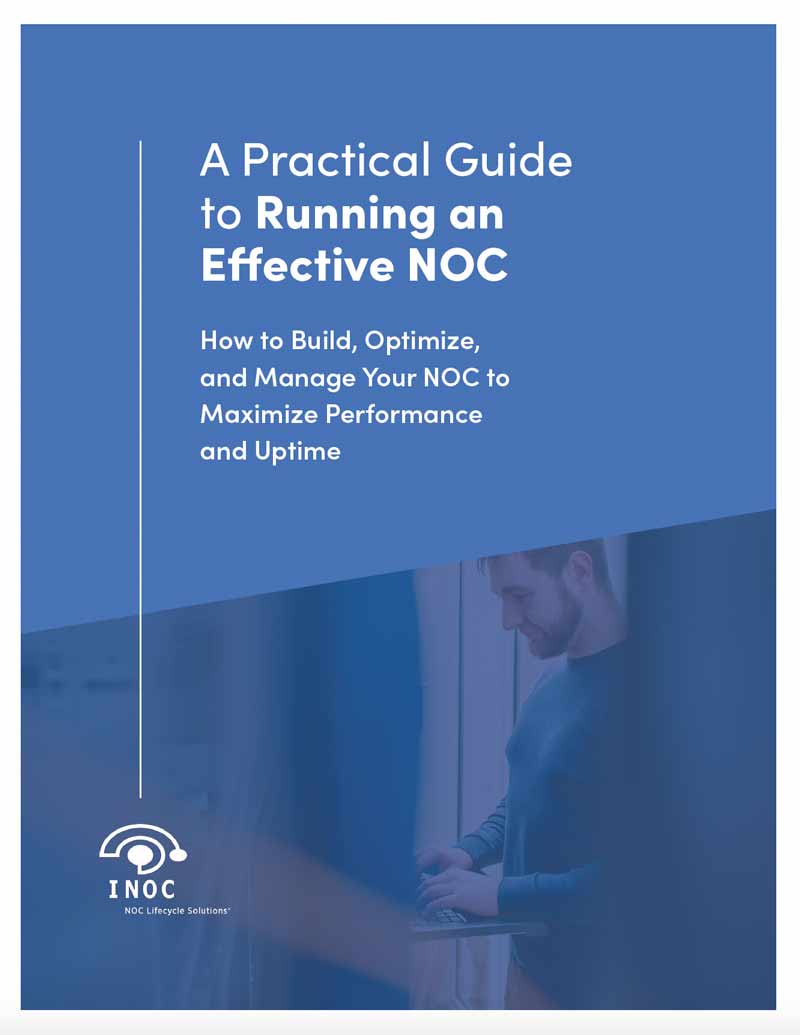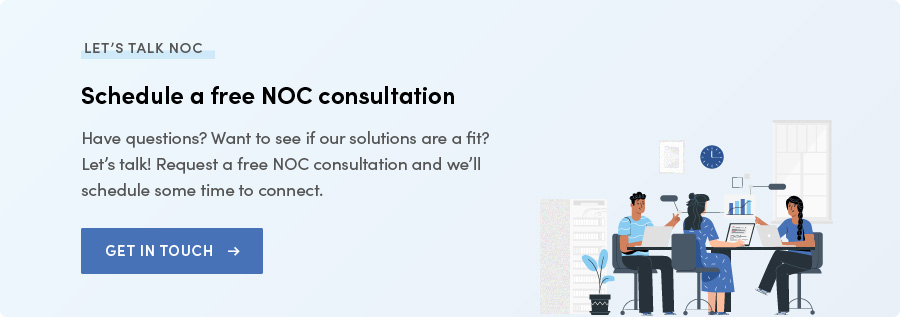In today's IT environments, the volume of alerts generated across networks, infrastructure, and applications has grown—sometimes exponentially. This flood of data creates a paradoxical situation: we have more information than ever about our systems, yet extracting meaningful, actionable intelligence has become increasingly difficult.
For Network Operations Centers (NOCs) worldwide, this challenge isn't just a technical inconvenience—it’s a fundamental threat to their ability to deliver reliable service.
This guide briefly explains the common correlation challenges we observe in NOCs and how we’ve solved them to provide fast, accurate support at scale.
The Correlation Challenge for Modern NOCs
Let me paint a picture that might be all too familiar: Imagine a medium-sized enterprise with approximately 300 devices on its network. This environment typically generates over 1,200 events during peak hours—every single day. For larger service providers with 700+ devices, that number can easily exceed 35,000 events per week.
Behind these statistics lies a troubling reality: NOC engineers are drowning in alerts. They're forced to manually sift through thousands of notifications, attempting to identify which ones matter and how they might be related. It's the equivalent of trying to find a specific conversation in a stadium full of people all talking at once. It’s been like this for years in most NOCs—and most teams have (sadly) normalized the problem.
The results of letting it go unsolved are predictable and familiar:
- Critical incidents get buried in the noise. When everything appears urgent, nothing is urgent. Truly important alerts get lost among hundreds of non-actionable notifications.
- Detection and response times suffer. Without proper correlation, engineers waste precious minutes—sometimes hours or longer—trying to simply understand the scope and impact of an incident, let alone fix it.
- Root causes remain elusive. When alerts are treated as isolated events rather than symptoms of underlying problems, technicians chase symptoms rather than addressing fundamental issues.
- Resources are misallocated. High-tier engineers spend valuable time processing low-level alerts that could be handled by entry-level staff or automated systems.
- Customer experience deteriorates. The delay between problem occurrence and resolution directly impacts service quality and customer satisfaction.
This situation creates a vicious cycle we see in almost every NOC and support function we step into. As alert volumes increase, NOC teams become more selective about which ones they address, often implementing crude filtering mechanisms that can inadvertently mask important signals. Meanwhile, the business bears mounting costs: extended outages, inefficient resource utilization, employee burnout, and damaged client relationships.
More than once, network operations leaders we spoke with describe their environments as "an endless wall of red alerts" where engineers had more or less become numb to the constant stream of notifications. Their team was focused on clearing alerts from the dashboard rather than solving actual problems—a dangerous inversion of priorities that had become their standard operating procedure. Again, when chaos goes unaddressed for long enough, it gets normalized—all to the detriment of the business and its end-users or customers.
The Business Impact of Poor Event Correlation
The technical challenges of inadequate (or absent) event correlation are clear, but the business implications are equally significant and often under-appreciated, because they “quietly” exact a toll without calling direct attention to themselves.
Consider what happens when a critical application experiences an outage:
Without effective event correlation, the NOC receives dozens or even hundreds of distinct alerts—from network devices, servers, storage systems, and the application itself. Each of these alerts appears as a separate issue requiring investigation.
Instead of immediately identifying and addressing the root cause, engineers chase multiple symptoms simultaneously. They might spend 30 minutes (or much longer) troubleshooting a server while the actual problem is a failed network switch.
Meanwhile, the business faces:
- Extended downtime costs: For years, the industry relied on the widely quoted figure of $5,600 per minute to estimate the cost of IT outages. But in 2022, EMA Research challenged that benchmark—placing the average cost of unplanned downtime at $12,900 per minute. And the trend hasn’t slowed. Today, the average has climbed to $14,056 per minute, with large enterprises facing potential losses as high as $23,750 per minute. (Of course, these figures don’t appear neatly in a report. Many of the true costs—like reputation damage, lost productivity, and missed opportunities—are difficult, if not impossible, to fully quantify.)
- Resource waste: Highly skilled (and highly paid) engineers spend time on low-value activities, investigating alerts that could have been automatically correlated if only the tooling was in place to do so.
- Diminished customer confidence: For service providers, every minute of unnecessary downtime erodes client trust and undermines SLA commitments.
- Lost competitive advantage: Teams that can’t quickly identify and resolve IT incidents increasingly find themselves at a disadvantage against more operationally mature competitors. This is another problem that doesn’t call attention to itself despite exacting a potentially massive aggregate opportunity cost.
One particularly troubling pattern we've observed is what I call the "false all-clear syndrome." Without proper correlation, NOC teams may resolve what they believe to be the primary incident while missing related issues that will trigger subsequent failures.
The customer experiences a brief restoration of service followed by another outage—a scenario that damages credibility far more than a single extended outage.
At a regional fiber-optic provider we worked with, this exact situation played out repeatedly. Their NOC would receive alerts about fiber hut power issues, address what seemed to be the immediate problem, and declare victory—only to have services fail again hours later due to related but undetected issues in their power systems. The result was a terrible cycle of customer frustration that became increasingly hard to break.
We’ve come to learn that these cycles are more prevalent than anyone should feel comfortable with or would care to admit.
The Traditional Approach and Its Limitations
Now let’s look at why most correlation “solutions” don’t work. Historically, organizations have attempted to solve the event correlation challenge through several approaches:
Rule-based systems apply predefined patterns to identify relationships between events. While straightforward to implement, these systems struggle with novel situations and require constant maintenance as environments evolve.
Temporal correlation assumes that events occurring within close time proximity are likely related—which isn’t always true. This approach can be effective for obvious failures but generates numerous false positives in complex environments. In other words, the more complex the environment, the worse this approach typically works.
Topology-based correlation uses knowledge of infrastructure relationships to connect events. While powerful when accurate, maintaining a comprehensive and current topology map is extraordinarily difficult in dynamic environments. Read our other explainer on NOC CMDBs for a deeper dive into this area, specifically.
Ticket-based correlation attempts to group alerts by manually associating them with trouble tickets. This method is probably the most effective, but places the correlation burden on already-overwhelmed NOC staff. It’s infeasible in high-volume support environments and also invites the errors and inconsistency of anything left entirely to human attention.
To be clear: each of these approaches offers some value, but none provide a comprehensive solution to the fundamental challenge: extracting meaningful signal from overwhelming noise in increasingly complex IT environments.
These traditional approaches also share a fatal limitation: they depend heavily on human configuration, rule definition, and maintenance. As environments grow more complex and dynamic, the manual effort required becomes unsustainable. Teams find themselves in an endless cycle of tuning rules and adjusting thresholds, forever one step behind the evolving infrastructure:
| 1. Engineers have to create tickets in the ITSM system. | 2. Relevant alerts must be attached or referenced “by hand.” | 3. Configuration items must be identified and linked. | 4. Impact assessments must be performed manually. | 5. Historical context must be researched and added. |
The INOC Approach: AIOps-Driven Event Correlation
At INOC, we're uniquely positioned, resourced, and incentived to actually solve this problem. We’ve developed a fundamentally different approach to event correlation—one that leverages advanced machine learning and automation while maintaining the critical human oversight needed for high-stakes IT operations.
The core of our solution is the INOC Ops 3.0 Platform, which applies AIOps (Artificial Intelligence for IT Operations) principles to transform raw events into actionable intelligence. Rather than replacing human expertise, our platform augments it—removing the burden of routine correlation while providing engineers with the context they need to make informed decisions.
Below is a high-level schematic of our Ops 3.0 platform. Read our in-depth explainer for more on it.

The workflow generally moves from the left to the right of the diagram as monitoring tools output alarm and event information from a client NMS or ours into our platform, where a number of tools process and correlate that data, generate incidents and tickets enriched with critical information from our CMDB, and triage and work them through a combination of machine learning and human engineering resources. ITSM platforms are integrated to bring activities back into the client's support environment and the system is integrated with client communications.
Here's exactly how our approach differs from traditional correlation methods:
1. Intelligent event ingestion and normalization
Our platform ingests alarm and event data from virtually any client source—from traditional network management systems to specialized element management systems, application performance monitors, and cloud platforms. Unlike simple aggregation tools, we normalize this data into a consistent format while preserving the unique attributes needed for accurate correlation.
This approach allows our platform to work with existing monitoring tools rather than replacing them—one of the key differentiators that compels teams to work with us over other service providers. We can integrate with LogicMonitor, SolarWinds, New Relic, Nagios, OpenNMS, Dynatrace, and dozens of other platforms—preserving your investments (that you know and love) while enhancing their value. Keep your tools—inherit our capabilities.
2. Machine learning-driven correlation
Rather than relying solely on static rules, our correlation engine applies machine learning algorithms that continuously improve based on actual operational data. It gets smarter the more we use it. Each output is a teaching tool.
The system analyzes patterns across thousands of incidents to identify relationships that would be impossible for humans to detect manually. For example, when analyzing network outages, our system can identify subtle precursor events that consistently occur before major failures—even when these events appear unrelated to the human eye. This allows for earlier detection and, in many cases, prevention of service-impacting incidents.
3. Context-aware analysis
One of the most powerful aspects of our approach is the integration of correlation with our comprehensive Configuration Management Database (CMDB). Unlike basic CMDBs that merely catalog assets, our CMDB captures the complex relationships between infrastructure components and business services:
- Alarm data
- Location data
- Asset data
- Customer data
- Circuit data
- Third-party contact data
- Service data
When correlating events, our platform doesn't just identify technical relationships—it determines business impact. This means we can distinguish between an alert affecting a redundant system component (important but not urgent) and one impacting a critical customer-facing service (requiring immediate attention). This lets us intelligently prioritize incidents based on actual severity.
4. Automated incident creation with intelligent enrichment
Once correlations are established, our platform automatically creates incident tickets enriched with all relevant context. NOC engineers don't just see that a router is down—they see which services are impacted, what related components show warnings, which customers are affected, and what historical patterns might be relevant.
This enrichment dramatically reduces the "investigation tax" that plagues most NOC operations. In traditional environments, we find that engineers often spend 30-50% of their time simply gathering context before they can begin meaningful troubleshooting. Our approach delivers this context automatically, allowing engineers to immediately focus on resolution.
5. Continuous learning and refinement
Maybe most importantly, our correlation engine continuously “learns” and improves. Every incident becomes a data point that enhances future correlations. If a particular pattern of events consistently precedes a specific type of outage, the system will identify this relationship and flag it proactively in future scenarios.
This learning capability extends to false positives as well. When our engineers determine that correlated events weren't actually related, the system incorporates this feedback, reducing similar false correlations in the future.
The Results: AIOps-Driven Event Correlation
The impact of this approach on NOC operations is pretty profound. When implemented effectively, our event correlation capabilities typically deliver:
- 60-80% reduction in actionable alerts requiring human attention.
- 50% faster incident analysis due to automated context enrichment.
- 45% reduction in time-to-action after alert notification.
- 30% decrease in Mean Time to Resolution (MTTR).
- A growing number of incidents auto-resolved without human intervention.
These metrics translate directly to business value. For one global technology services provider, our implementation resulted in a 30% auto-resolution rate for incidents and reduced major escalations from 123 in 2022 to just 18 in 2023. For AT&T Business, our platform streamlined operations across multiple sites, reducing NOC support onboarding time from 6 weeks to just 1 week.
Beyond these quantitative benefits, our clients report significant qualitative improvements:
- Enhanced staff focus: NOC engineers spend more time on complex, high-value problems rather than processing routine alerts.
- Improved operational visibility: Management gains insight into actual incident patterns rather than symptom-level alerts.
- Greater predictability: Proactive identification of emerging issues reduces unexpected outages.
- Stronger customer relationships: Faster resolution and more accurate impact assessment build client confidence.
The Build vs. Buy Decision: Why Outsourcing Makes Sense
Given the clear benefits of advanced event correlation, teams face a critical question: should they build this capability internally or partner with a specialized provider?
While building in-house correlation capabilities is theoretically possible, the practical challenges are formidable:
- Technology investment: Implementing a comprehensive correlation platform requires significant capital expenditure on software licenses, integration services, and ongoing maintenance.
- Expertise gap: Effective event correlation requires specialized skills in data science, machine learning, and IT operations—a rare combination that commands premium salaries.
- Time to value: Building and tuning a correlation engine typically takes 12-18 months before delivering meaningful results, during which operational challenges persist.
- Operational focus: Maintaining correlation systems diverts resources from core business initiatives, creating an ongoing operational burden.
Most importantly, correlation engines require massive amounts of operational data to learn effectively. An internal platform starts with zero historical context, while established providers bring years of patterns and insights from similar environments.
This is precisely why many organizations—even those with substantial IT resources—choose to leverage specialized NOC providers with established correlation capabilities. By doing so, they gain immediate access to mature technology and expertise without the capital expenditure, hiring challenges, or extended implementation timelines.
Final Thoughts and Next Steps
The explosion of monitoring data in modern IT environments has created both a challenge and an opportunity. Organizations drowning in alerts can transform this flood of information into a strategic advantage—but only with the right approach to event correlation.
At INOC, we've seen firsthand how intelligent correlation can revolutionize NOC operations. By combining machine learning with human expertise, our platform eliminates alert noise, accelerates incident resolution, and enables truly proactive operations. The result is not just better technical metrics, but meaningful business impact: reduced downtime, optimized resources, and enhanced customer satisfaction.
As IT environments continue to grow in complexity, the gap between traditional approaches and modern correlation will only widen. Organizations that embrace AIOps-driven correlation—whether through internal development or partnership with specialized providers—will gain significant operational advantages over those still relying on manual triage and rule-based systems.
The most successful organizations will be those that recognize event correlation not merely as a technical feature, but as a strategic capability that directly impacts their ability to deliver reliable, responsive IT services in an increasingly demanding business environment.
Contact us to schedule a discovery session to learn more about our correlation engine and all the efficiencies we bring to NOC support workflows.

Free white paper A Practical Guide to Running an Effective NOC
Download our free white paper and learn how to build, optimize, and manage your NOC to maximize performance and uptime.







